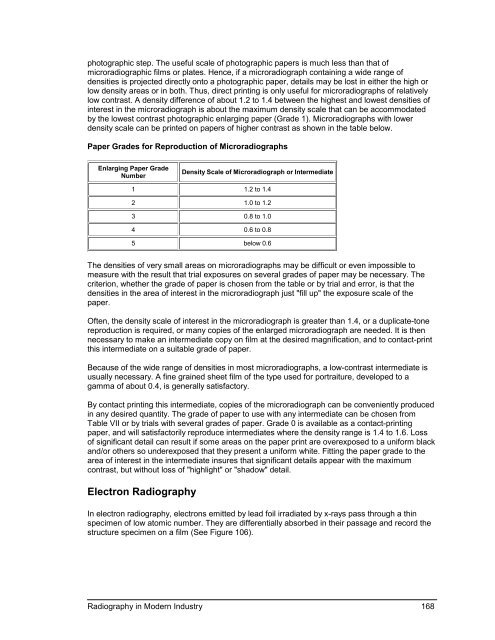Radiography in Modern Industry - Kodak
Radiography in Modern Industry - Kodak
Radiography in Modern Industry - Kodak
You also want an ePaper? Increase the reach of your titles
YUMPU automatically turns print PDFs into web optimized ePapers that Google loves.
photographic step. The useful scale of photographic papers is much less than that ofmicroradiographic films or plates. Hence, if a microradiograph conta<strong>in</strong><strong>in</strong>g a wide range ofdensities is projected directly onto a photographic paper, details may be lost <strong>in</strong> either the high orlow density areas or <strong>in</strong> both. Thus, direct pr<strong>in</strong>t<strong>in</strong>g is only useful for microradiographs of relativelylow contrast. A density difference of about 1.2 to 1.4 between the highest and lowest densities of<strong>in</strong>terest <strong>in</strong> the microradiograph is about the maximum density scale that can be accommodatedby the lowest contrast photographic enlarg<strong>in</strong>g paper (Grade 1). Microradiographs with lowerdensity scale can be pr<strong>in</strong>ted on papers of higher contrast as shown <strong>in</strong> the table below.Paper Grades for Reproduction of MicroradiographsEnlarg<strong>in</strong>g Paper GradeNumberDensity Scale of Microradiograph or Intermediate1 1.2 to 1.42 1.0 to 1.23 0.8 to 1.04 0.6 to 0.85 below 0.6The densities of very small areas on microradiographs may be difficult or even impossible tomeasure with the result that trial exposures on several grades of paper may be necessary. Thecriterion, whether the grade of paper is chosen from the table or by trial and error, is that thedensities <strong>in</strong> the area of <strong>in</strong>terest <strong>in</strong> the microradiograph just "fill up" the exposure scale of thepaper.Often, the density scale of <strong>in</strong>terest <strong>in</strong> the microradiograph is greater than 1.4, or a duplicate-tonereproduction is required, or many copies of the enlarged microradiograph are needed. It is thennecessary to make an <strong>in</strong>termediate copy on film at the desired magnification, and to contact-pr<strong>in</strong>tthis <strong>in</strong>termediate on a suitable grade of paper.Because of the wide range of densities <strong>in</strong> most microradiographs, a low-contrast <strong>in</strong>termediate isusually necessary. A f<strong>in</strong>e gra<strong>in</strong>ed sheet film of the type used for portraiture, developed to agamma of about 0.4, is generally satisfactory.By contact pr<strong>in</strong>t<strong>in</strong>g this <strong>in</strong>termediate, copies of the microradiograph can be conveniently produced<strong>in</strong> any desired quantity. The grade of paper to use with any <strong>in</strong>termediate can be chosen fromTable VII or by trials with several grades of paper. Grade 0 is available as a contact-pr<strong>in</strong>t<strong>in</strong>gpaper, and will satisfactorily reproduce <strong>in</strong>termediates where the density range is 1.4 to 1.6. Lossof significant detail can result if some areas on the paper pr<strong>in</strong>t are overexposed to a uniform blackand/or others so underexposed that they present a uniform white. Fitt<strong>in</strong>g the paper grade to thearea of <strong>in</strong>terest <strong>in</strong> the <strong>in</strong>termediate <strong>in</strong>sures that significant details appear with the maximumcontrast, but without loss of "highlight" or "shadow" detail.Electron <strong>Radiography</strong>In electron radiography, electrons emitted by lead foil irradiated by x-rays pass through a th<strong>in</strong>specimen of low atomic number. They are differentially absorbed <strong>in</strong> their passage and record thestructure specimen on a film (See Figure 106).<strong>Radiography</strong> <strong>in</strong> <strong>Modern</strong> <strong>Industry</strong> 168
















